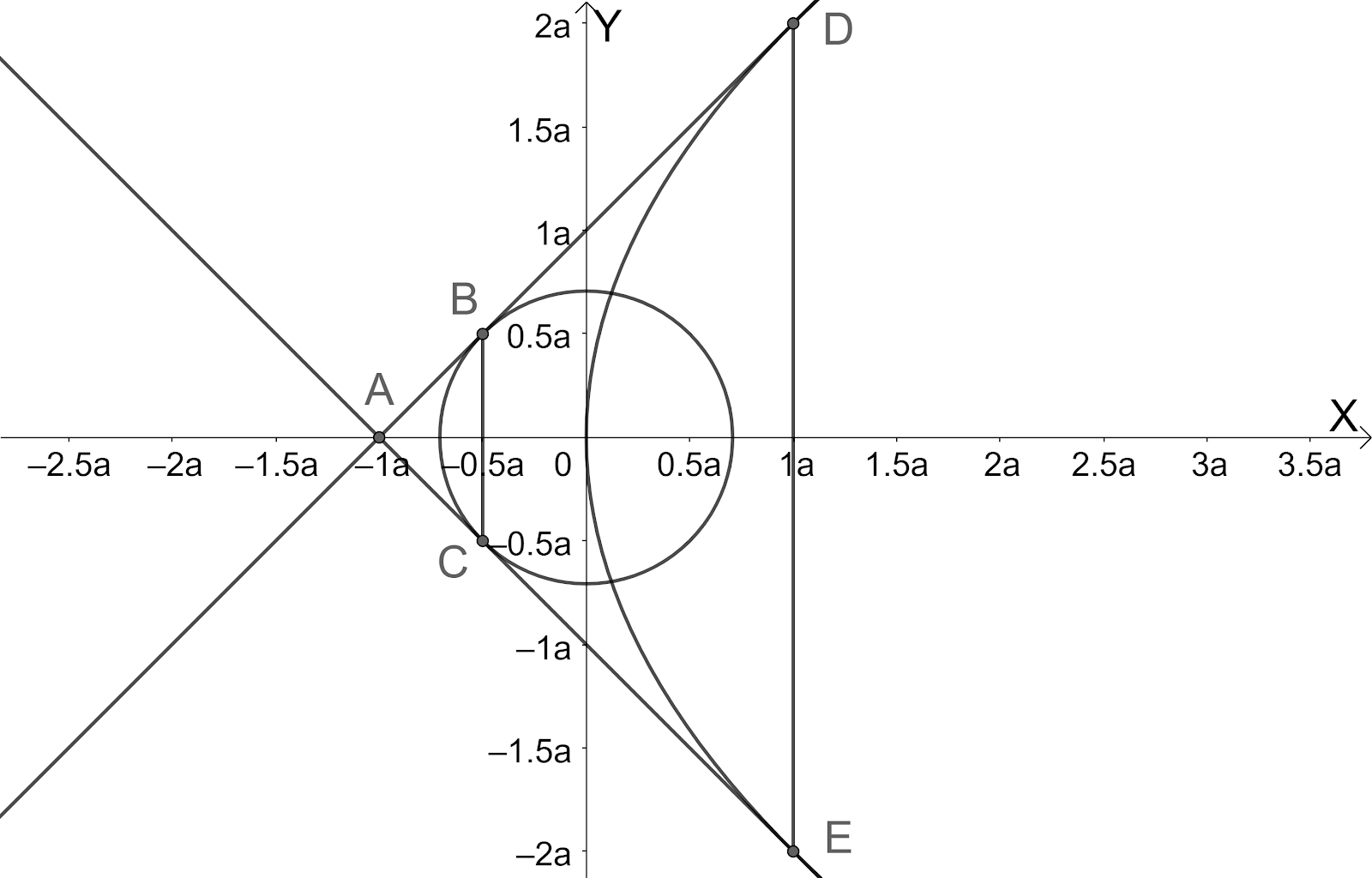Question
Question: From a point A, common tangents are drawn to the circle \({{x}^{2}}+{{y}^{2}}=\dfrac{{{a}^{2}}}{2}\)...
From a point A, common tangents are drawn to the circle x2+y2=2a2 and the parabola y2=4ax. Find the area of the quadrilateral formed by the common tangents, the chord of contact of the circle and the chord of contact of the parabola?
Solution
We start solving the problem by drawing the figure representing the given figure. We then make use of the fact that the slope form of the equation of the tangent to the parabola y2=4ax is y=mx+ma⇔mx−y+ma=0. We then apply the fact that the perpendicular distance from the centre of the circle to any of its tangent is equal to its radius to get the slope of tangent. We then find the equations of the chord of contact to the given circle and parabola. We then find the points of intersections of these chords with the tangents which are the vertices of the quadrilateral. We then make use of the fact that the area of the quadrilateral with vertices (x1,y1), (x2,y2), (x3,y3) and (x4,y4) is Δ=21x1−x3 y1−y3 x2−x4y2−y4. We then make the necessary calculations to get the required value of the area of the quadrilateral.
Complete answer:
According to the problem, we are given that common tangents were drawn to the circle x2+y2=2a2 and the parabola y2=4ax from point A. We need to find the area of the quadrilateral formed by the common tangents, the chord of contact of the circle and the chord of contact of the parabola.
Let us draw the figure representing the given information.

We know that the slope form of the equation of the tangent to the parabola y2=4ax is y=mx+ma⇔mx−y+ma=0. But this is also tangent to the circle x2+y2=2a2.
We know that the perpendicular distance from the centre of the circle to any of its tangent is equal to its radius.
So, we get 2a=m2+(−1)2m(0)−0+ma.
⇒2a=m2+1ma.
Let us square on both sides.
⇒(2a)2=m2+1ma2.
⇒2a2=m2+1m2a2.
⇒2a2=m2(m2+1)a2.
⇒m4+m2=2.
⇒m4+m2−2=0.
⇒m4+2m2−m2−2=0.
⇒m2(m2+2)−1(m2+2)=0.
⇒(m2−1)(m2+2)=0.
We know that m2+2>0. So, we have m2−1=0.
⇒m2=1.
⇒m=±1.
So, the equations of the tangents are y=±(x+a) ---(1).
Let us find the point of intersection of these tangents.
So, we have −(x+a)=+(x+a).
⇒−x−a=x+a.
⇒−a−a=x+x.
⇒2x=−2a.
⇒x=−a ---(2).
Let us substitute equation (2) in equation (1).
⇒y=±(−a+a).
⇒y=±(0).
⇒y=0.
So, the intersection point of the tangents is A(−a,0) ---(3).
We know that the equation of the chord of contact for a circle x2+y2+2gx+2fy+c=0 from the point (x1,y1) is defined as xx1+yy1+g(x+x1)+f(y+y1)+c=0.
So, we get the chord of contact BC from the point A(−a,0) as x(−a)+y(0)=2a2.
⇒−xa=2a2.
⇒x=2−a ---(4).
Now, let us find the points of intersection chord of contact x=2−a with the tangents y=±(x+a).
So, we have y=±(2−a+a).
⇒y=±(2a).
So, the points of intersection chord of contact x=2−a with the tangents y=±(x+a) are B(2−a,2a) and C(2−a,2−a) ---(5).
We know that the equation of the chord of contact for a circle y2=4ax from the point (x1,y1) is defined as yy1=2a(x+x1).
So, we get the chord of contact DE from point A(−a,0) as y(0)=2a(x−a).
⇒0=2a(x−a).
⇒x−a=0.
⇒x=a ---(6).
Now, let us find the points of intersection chord of contact x=a with the tangents y=±(x+a).
So, we have y=±(a+a).
⇒y=±(2a).
So, the points of intersection chord of contact x=a with the tangents y=±(x+a) are D(a,2a) and E(a,−2a) ---(7).
Now, let us find the area of the quadrilateral BCED whose vertices are B(2−a,2a), C(2−a,2−a), E(a,−2a) and D(a,2a).
We know that the area of the quadrilateral with vertices (x1,y1), (x2,y2), (x3,y3) and (x4,y4) is Δ=21x1−x3 y1−y3 x2−x4y2−y4.
So, we have Δ=212−a−a 2a+2a 2−a−a2−a−2a.
⇒Δ=212−3a 25a 2−3a2−5a ---(8).
We know that w y xz=(w×z)−(y×x). Let us use this in equation (8).
⇒Δ=21×(2−3a×2−5a)−(25a×2−3a).
⇒Δ=21×(415a2)−(4−15a2).
⇒Δ=21×(415a2+415a2).
⇒Δ=21×(430a2).
⇒Δ=415a2 sq.units.
∴ We have found the area of the quadrilateral formed by the common tangents, the chord of contact of the circle and the chord of contact of the parabola as 415a2 sq.units.
Note:
We can see that the given problem contains a huge amount of calculation, so we need to perform each step carefully to avoid confusion and calculation mistakes. We can see that the quadrilateral formed is isosceles trapezium so, we can divide them into a combination of square and right-angle triangles to get the required area. We can also find the area of the obtained quadrilateral by dividing it into two triangles. Similarly, we can expect the problems to find the area of the quadrilateral formed with the normal of the tangents.
